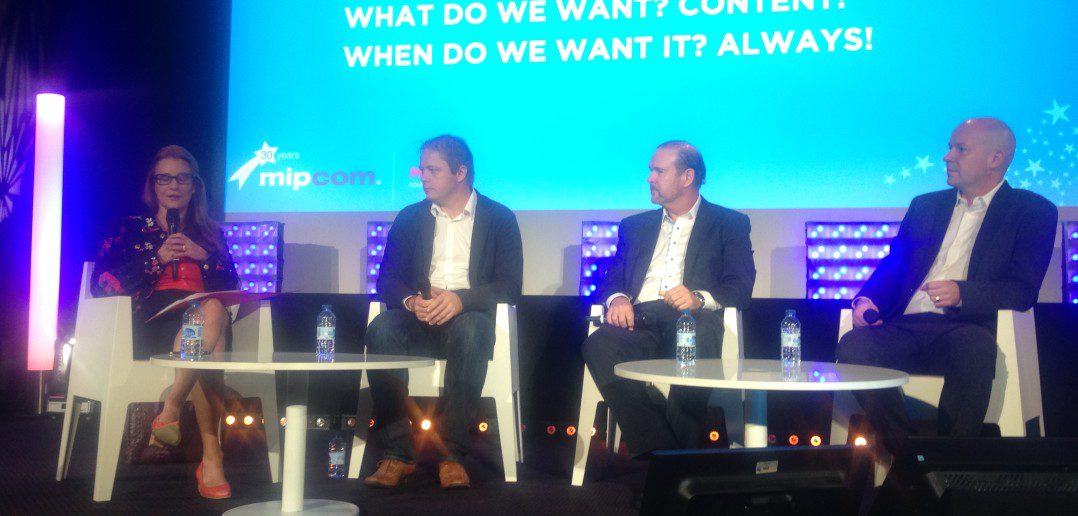Moderator Catherine Warren, president, FanTrust Entertainment Strategies & board member, Bell Fund; Kristian Bruaroy, head of TV 2 Sumo; Jim Packer, president, Lionsgate; Sam Toles, vice president, content acquisitions & business development, Vimeo.
The stakes are high: People want content anytime, anywhere, on any device. But how do you accommodate demand while protecting your rights? How do you manage catch-up and other windows to best exploit your library and still meet fans’ needs? Our panelists ruminated over these questions, and more, in this morning’s digital distribution-focused sessions. A few highlights follow.
Online video platform Vimeo focuses on curation, according to Toles, because the world is loaded with content and it’s so hard to find anything to watch: « There are 11 feature films rolling out in postproduction in the US every single day. That’s 4000 films a year. How can anyone possibly watch that much content? » That’s why Vimeo takes « a manual and organic approach to surfacing content to an audience of 170m unique viewers a month. »
Vimeo lets to host both free content and for-pay content. You can take trailers for the pay content and embed them anywhere; the film is « bonded » behind the trailer, so « wherever you embed, that place becomes your storefront, » Toles said. « People can buy that content, save it to their queue and watch it on all the connected devices Vimeo has placed itself in. We’re really about connecting audience and content together. »
Its biggest difference from YouTube is its « lack of ads and quality of player, » said Toles. « People come to Vimeo to surface content that’s higher end and professionally produced; this is an excellent avenue to convert those viewers into paying customers as opposed to serving ads. »
He went on, « We believe that people are willing to pay for content they’re passionate about. » The question is, how does one migrate that massive audience, and attach them to films they’d be passionate about buying?
« We challenged our own windows, » said Bruaroy. « We took a big drama series and put it up for binge-viewing. TV executives were like, ‘you have to do this because now we have this beautiful customer base, you have to give them more content’. And the analytics showed that this didn’t cannibalise. We should experiment more with this kind of internal windowing. »
Packer demonstrated more caution. « Be mindful of people who want the content when they want, but you have to be smart when you window, » he said.
At Lionsgate, « when we do the deals, we think about how the content will be utilised, » Packer went on. « We’re challenging windows all the time: our deal with Orange is the New Black in China is a good example. »
In China, Orange is the New Black went live on content site Youku a mere 24 hours after the US launch, alongside Lionsgate titles like Hotel Rwanda, Monster’s Ball and Mr. Magorium’s Wonder Emporium—an effort to fight piracy in China by simply availing content legitimately.
« There’s a whole dynamic where you have to be smart, not only how you window, but also how you think about other places that you window. There’s a lot of connectivity between countries, different windows and different shows. You have to be smart to maximise it, » said Packer.
He also talked about how promotion can change how your content fares, a process he called « creative windowing ».
« I understand that you’d like to have all the windows. And I’ll do my best to exploit the windows, » said Buaroy. « But you have an audience that doesn’t know anything about rights. » He gave the example of availing Season 1 of a show for binge-watching, creating a certain audience expectation for Season 2. « But when we launch Season 2, we only have catchup rights then. And people don’t understand this. How do you explain this to them? »
« If one door closes, you need to have the other open, » Packer replied. « This is a content ecosystem and as long as you treat the customer with respect » by not overpricing things, you’ll be respected back. Packer pointed to how customers sometimes drive each other to other legitimate purchasing spaces when an avenue goes dark. « I’ve seen people in comments say things like ‘Well, I know they took it off on-demand, but you can buy it here and here’. »
Finally, the use of data—social or otherwise—is of increasing importance in making business decisions. Netflix doesn’t provide data for its original series like Orange is the New Black, said Packer, which obliges Lionsgate to find other methods of gathering data to sell the show.
« We’re gonna look at social, their user interface, and we’re gonna create analytics around that so we can go to the market and say ‘It’s the most-tweeted-about show for this period’. We’re gonna come up with 19 different ways to use the data to help our case, » he said.




